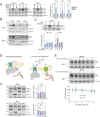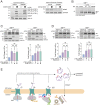RPL26/uL24 UFMylation is essential for ribosome-associated quality control at the endoplasmic reticulum
- PMID: 37036982
- PMCID: PMC10120006
- DOI: 10.1073/pnas.2220340120
RPL26/uL24 UFMylation is essential for ribosome-associated quality control at the endoplasmic reticulum
Abstract
Ribosomes that stall while translating cytosolic proteins are incapacitated by incomplete nascent chains, termed "arrest peptides" (APs) that are destroyed by the ubiquitin proteasome system (UPS) via a process known as the ribosome-associated quality control (RQC) pathway. By contrast, APs on ribosomes that stall while translocating secretory proteins into the endoplasmic reticulum (ER-APs) are shielded from cytosol by the ER membrane and the tightly sealed ribosome-translocon junction (RTJ). How this junction is breached to enable access of cytosolic UPS machinery and 26S proteasomes to translocon- and ribosome-obstructing ER-APs is not known. Here, we show that UPS and RQC-dependent degradation of ER-APs strictly requires conjugation of the ubiquitin-like (Ubl) protein UFM1 to 60S ribosomal subunits at the RTJ. Therefore, UFMylation of translocon-bound 60S subunits modulates the RTJ to promote access of proteasomes and RQC machinery to ER-APs.
Keywords: UFM1; UFMylation; endoplasmic reticulum; ribosome-associated quality control; ubiquitin.
Conflict of interest statement
The authors declare no competing interest.
Figures





Update of
-
RPL26/uL24 UFMylation is essential for ribosome-associated quality control at the endoplasmic reticulum.bioRxiv [Preprint]. 2023 Mar 9:2023.03.08.531792. doi: 10.1101/2023.03.08.531792. bioRxiv. 2023. Update in: Proc Natl Acad Sci U S A. 2023 Apr 18;120(16):e2220340120. doi: 10.1073/pnas.2220340120. PMID: 36945571 Free PMC article. Updated. Preprint.
Similar articles
-
UFMylation orchestrates spatiotemporal coordination of RQC at the ER.Sci Adv. 2025 May 2;11(18):eadv0435. doi: 10.1126/sciadv.adv0435. Epub 2025 May 2. Sci Adv. 2025. PMID: 40315331 Free PMC article.
-
RPL26/uL24 UFMylation is essential for ribosome-associated quality control at the endoplasmic reticulum.bioRxiv [Preprint]. 2023 Mar 9:2023.03.08.531792. doi: 10.1101/2023.03.08.531792. bioRxiv. 2023. Update in: Proc Natl Acad Sci U S A. 2023 Apr 18;120(16):e2220340120. doi: 10.1073/pnas.2220340120. PMID: 36945571 Free PMC article. Updated. Preprint.
-
UFMylation of RPL26 links translocation-associated quality control to endoplasmic reticulum protein homeostasis.Cell Res. 2020 Jan;30(1):5-20. doi: 10.1038/s41422-019-0236-6. Epub 2019 Oct 8. Cell Res. 2020. PMID: 31595041 Free PMC article.
-
The UFM1 system: Working principles, cellular functions, and pathophysiology.Mol Cell. 2024 Jan 4;84(1):156-169. doi: 10.1016/j.molcel.2023.11.034. Epub 2023 Dec 22. Mol Cell. 2024. PMID: 38141606 Review.
-
Ribosome-associated quality control of membrane proteins at the endoplasmic reticulum.J Cell Sci. 2020 Nov 27;133(22):jcs251983. doi: 10.1242/jcs.251983. J Cell Sci. 2020. PMID: 33247003 Free PMC article. Review.
Cited by
-
Allelic strengths of encephalopathy-associated UBA5 variants correlate between in vivo and in vitro assays.Elife. 2023 Dec 11;12:RP89891. doi: 10.7554/eLife.89891. Elife. 2023. PMID: 38079206 Free PMC article.
-
NEMF-mediated CAT tailing facilitates translocation-associated quality control.J Cell Biol. 2025 Jun 2;224(6):e202408199. doi: 10.1083/jcb.202408199. Epub 2025 Apr 21. J Cell Biol. 2025. PMID: 40257401
-
The UFM1 E3 ligase recognizes and releases 60S ribosomes from ER translocons.Nature. 2024 Mar;627(8003):437-444. doi: 10.1038/s41586-024-07093-w. Epub 2024 Feb 21. Nature. 2024. PMID: 38383789 Free PMC article.
-
UFMylation orchestrates spatiotemporal coordination of RQC at the ER.Sci Adv. 2025 May 2;11(18):eadv0435. doi: 10.1126/sciadv.adv0435. Epub 2025 May 2. Sci Adv. 2025. PMID: 40315331 Free PMC article.
-
Integrated multi-omics analysis and functional validation uncovers RPL26 roles in regulating growth traits of Asian water buffaloes (Bubalus bubalis).BMC Genomics. 2025 May 8;26(1):456. doi: 10.1186/s12864-025-11618-6. BMC Genomics. 2025. PMID: 40340823 Free PMC article.
References
Publication types
MeSH terms
Substances
Grants and funding
LinkOut - more resources
Full Text Sources
Molecular Biology Databases
Miscellaneous

